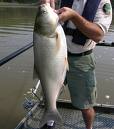 Invasive species take over new habitats so quickly because they usually have no natural predators in their new home, allowing them to reproduce quickly and overwhelm native populations competing for the same food. The latest foreign invader to make headlines in the U.S. is Asian Carp, a fast-moving, quick-breeding intruder that has taken over the Mississippi and Ohio watersheds with amazing speed.
Invasive species take over new habitats so quickly because they usually have no natural predators in their new home, allowing them to reproduce quickly and overwhelm native populations competing for the same food. The latest foreign invader to make headlines in the U.S. is Asian Carp, a fast-moving, quick-breeding intruder that has taken over the Mississippi and Ohio watersheds with amazing speed.
The carp was originally brought to the U.S. by catfish farmers in southern states to control plant growth in stock ponds. Unfortunately, they escaped during seasonal flooding and ended up in the lower Mississippi. Within a few years Asian Carp were being discovered all over the upper Mississippi and Ohio rivers. Now many conservationists fear the carp will end up in the Great Lakes, placing that entire ecosystem at risk.
The problem with Asian Carp is they don’t have any natural predators in American waters. Some restaurateurs on the Upper Mississippi near Minnesota’s Twin Cities are looking to change that.
They’ve proposed placing Asian Carp on menus along the entire Mississippi and Ohio watershed in order to encourage a fishing industry that could lead to the decimation of the invader’s population. Apparently, Asian Carp has a mild white meat with relatively few bones, which appeals perfectly to American palates.
The main obstacle in the way of successfully marketing Asian Carp on menus across the midsection of the U.S. is the name Asian Carp itself. Nobody wants to eat a carp. Some have suggested renaming the fish “Silverfin” to make it sound more appealing to hungry restaurant patrons.
Renaming worked for Chilean Seabass and Orange Roughy, both restaurant staples with previously unappealing names (“Patagonian toothfish” and “slimehead,” respectively). Marketing silverfin has yet to find any serious traction, but it seems like it would take a relatively small amount of seed money to make it popular on menus from Minnesota to New Orleans.
 Corner Booth Blog | TundraFMP Restaurant Supply, News & Equipment Blog
Corner Booth Blog | TundraFMP Restaurant Supply, News & Equipment Blog




It’s only a matter of time before this fish ends up in the Great Lakes. It won’t be the first unwelcome invader the Great Lakes region has seen. The Sea Lamprey, like the Asian Carp, has no natural predators and nearly devastated the fishing of the Great Lakes. The upside as you mention is the potential for this to be come a staple in American restaurants. Whereas the Sea Lamprey offered no economic value. A name change is in order though.
Asian Carp and similar white river fish are staple on menus throughout China…and the white flesh is delicious, flaky when prepped well, and with sweet/sour or peppery sauces popular in much of China, the fish is popular and much eaten. Hooray for the fishers…go get ’em! I’ll be one of the first to eat Asian Carp or SILVERFIN…whatever, this seems to be a potentially excellent solution to this intentionally invited invader. At least it should be a better seller on restaurant menus than nutria pate!